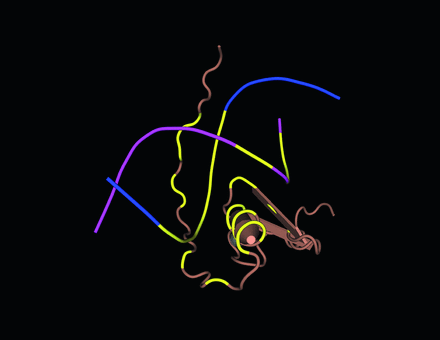The November issue of GENETICS is out now! Check out the Highlights below or the full Table of Contents here.
ISSUE HIGHLIGHTS
A novel statistical model to estimate host genetic effects affecting disease transmission, pp. 871—884
Osvaldo Anacleto, Luis Alberto Garcia-Cortes, Debby Lipschutz-Powell, John A. Woolliams, and Andrea B. Doeschl-Wilson
This article provides insight into how host genetic diversity affects disease spread, and offers novel means for disease control in livestock and predicting and controlling disease outbreaks in human populations. The authors introduce a novel statistical model for estimating genetic risks associated with the traits of host susceptibility to infection and heritable variation in disease transmission to susceptible individuals. They show that the model accurately estimates susceptibility and infectivity genetic parameters from incomplete time-to-infection data.
Inferring bottlenecks from genome-wide samples of short sequence blocks, pp. 1157—1169
Lynsey Bunnefeld, Laurent A. F. Frantz, and Konrad Lohse
These authors developed a novel way to facilitate likelihood-based population genomic inference by summarizing blocks of sequence data from small samples of individuals. They used a population bottleneck model to demonstrate the power of their method to detect past demographic events. The method is particularly useful for inference on non-model organisms, because long-range linkage and phase information is not required. It will also be applicable to a wide range of other models of population history.
Stimulation of chromosomal rearrangements by ribonucleotides, pp. 951—961
Hailey N. Conover, Scott A. Lujan, Mary J. Chapman, Deborah A. Cornelio, Rabab Sharif, Jessica S. Williams, Alan B. Clark, Francheska Camilo, Thomas A. Kunkel, and Juan Lucas Argueso
and
Elevated genome-wide instability in yeast mutants lacking RNase H activity, pp. 963—975
Karen O’Connell, Sue Jinks-Robertson, and Thomas D. Petes
RNA association with DNA can lead to genome instability. Conover et al. show that the recombinogenic effect of ribonucleotide incorporation during DNA replication is primarily caused by ribonucleotides incorporated by DNA polymerase  , with only minor contributions from DNA polymerases
, with only minor contributions from DNA polymerases  or
or  . Their results extend previous studies demonstrating that the mutagenicity of ribonucleotides is asymmetric between the nascent leading and lagging DNA strands. O’Connell et al. present data that suggests that RNA:DNA hybrids (R-loops) formed during transcription are a more significant source of genetic instability than misincorporated ribonucleotides. It’s no wonder that organisms have several RNAases for clearing their chromosomes of RNA.
. Their results extend previous studies demonstrating that the mutagenicity of ribonucleotides is asymmetric between the nascent leading and lagging DNA strands. O’Connell et al. present data that suggests that RNA:DNA hybrids (R-loops) formed during transcription are a more significant source of genetic instability than misincorporated ribonucleotides. It’s no wonder that organisms have several RNAases for clearing their chromosomes of RNA.
Extent of QTL reuse during repeated phenotypic divergence of sympatric threespine stickleback, pp. 1189—1200
Gina L. Conte, Matthew E. Arnegard, Jacob Best, Yingguang Frank Chan, Felicity C. Jones, David M. Kingsley, Dolph Schluter, and Catherine L. Peichel
Independent populations repeatedly evolve similar traits when adapting to similar environments. To what extent is the genetic basis of repeated evolution repeatable? Conte et al. studied this question using two pairs of threespine stickleback species that have independently adapted to similar environments by evolving many similar traits. They found that nearly half the genomic regions associated with the evolution of similar traits are the same in both species pairs, suggesting that repeated genetic evolution is pervasive. Might further understanding of why evolution is repeatable render it highly predictable?
The genomic impacts of drift and selection for hybrid performance in maize, pp. 1201—1211
Justin P Gerke, Jode W. Edwards, Katherine E. Guill, Jeffrey Ross-Ibarra, and Michael D. McMullen
Maize is naturally outcrossing, but modern breeding utilizes inbred lines in controlled crosses to produce hybrids. To understand the genomic impacts of hybrid breeding, Gerke et al. genotyped a pair of long-term experimental populations selected for hybrid performance. Their data suggest most of the observed loss of diversity is due to genetic drift. They also observed signals of selection in numerous regions of the genome. Their results point to simple complementation as the predominant mechanism of hybrid vigor.
Suppression of meiotic recombination by CENP-B homologs in Schizosaccharomyces pombe, pp. 897—904
Peter Johansen and Hugh P. Cam
Because homologous recombination in meiosis can lead to deleterious genome arrangements when it occurs at transposable elements, organisms have evolved mechanisms to suppress it. This article describes a pathway involving transposase-derived CENP-B proteins that recruit factors including Setl, NHEJ, and Condensin to suppress homologous recombination at Tf2 LTR retrotransposons in the fission yeast Schizosaccharomyces pombe.
Disruption of endocytosis with the dynamin mutant shibirets1 suppresses seizures in Drosophila, pp. 1087—1102
Jason R. Kroll, Karen G. Wong, Faria M. Siddiqui, and Mark A. Tanouye
Many epileptics are unable to control their seizures with current anti-epileptic drugs. Using Drosophila as a model for seizure disorders, Kroll et al. find that the shibirets1 mutation affecting Dynamin, which causes defects in synaptic vesicle recycling and endocytosis, is a powerful seizure suppressor. Interfering with synaptic vesicle regulation through Dynamin and various Rab GTPases also suppresses gain-of-function mutations in a gene homologous to human SCN1A, the most widely mutated gene in human epilepsy disorders. These results could point the way to the development of new classes of anti-epileptic drugs.
Asymmetric Wnt pathway signaling facilitates stem cell-like divisions via the non-receptor tyrosine kinase FRK-1 in Caenorhabditis elegans, pp. 1047—1060
Danielle Mila, Adriana Calderon, Austin T. Baldwin, Kelsey M. Moore, McLane Watson, Bryan T. Phillips, and Aaron P. Putzke
When a cell divides asymmetrically how is the development of the two daughter cells differently controlled? Mila et al.present a novel mechanism by which a non-receptor tyrosine kinase regulates asymmetric Wnt pathway signaling during stem cell divisions in Caenorhabditis elegans. Their findings reveal the complex nature of Wnt signaling in individual cells to achieve two daughter cells with different identities.













